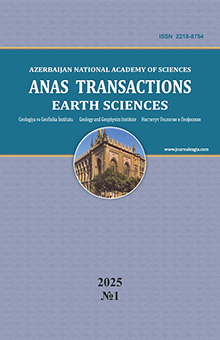Geochemical characteristics of the Gadabay intrusion complex in the study of magma evolution and tectonic pattern of the region (Lesser Caucasus, Azerbaijan territory)
Ministry of Science and Education of the Republic of Azerbaijan, Institute of Geology and Geophysics, Azerbaijan 119, H.Javid Ave., Baku, AZ1143: kenan.abbasov@gmail.com
Summary
The Gadabay intrusion complex which is located within the Lok-Garabakh structural-formation zone of the Lesser Caucasus is formed in two magmatic phases – gabbroid and granitic. Quartz diorites as the second phase are the most widespread rocks of the intrusion complex. Alkaline rocks such as monzodiorites and monzonites with limited distribution in the region are considered as a branch of the second phase. However, the results of ilmenite-titanomagnetite geothermometry show equal and higher crystallization temperatures of these alkaline rocks. Despite the detailed petrographic and field studies, the source of magmatic melts that formed the intrusion is not deeply studied. And trace element composition of rocks of Gadabay intrusion complex is worth to be investigated. Furthermore, distribution of trace elements in certain minerals can also be considered as a valuable information source. Distribution of Fe group elements (Ni, Cr, V, Co), alkaline earth elements (Sr, Ba), and rare earth elements (in the rocks of Gadabay intrusion complex is controlled by fractional crystallization. Hence, concentration of coherent elements and heavy rare earth elements decrease towards more evolved rock types, whereas concentration of incoherent elements and light rare earth elements increase. Next fact is that Gadabay intrusion complex has been formed within calc-alkaline magma series and primitive melt was formed as a result of partial melting of an enriched mantle substrate which is proved by diagrams composed base on trace elements’ ratios.
Keywords: Gadabay intrusion, REE elements, iron group elements, trace elements, classification diagrams, lithospheric mantle, partial melting, composition of primitive melts
REFERENCES
Abbasov K.F. Determination of the physicochemical conditions for the formation of rocks of the Gadabay intrusion based on the composition of ilmenite and titanomagnetite. Proceedings of Voronezh State Univeersity, Series: Geology, No.1, 2023, pp. 29-38 (in Russian).
Abdullaev R.N. et al. Age division of the magmatic formations in the north-eastern part of the Lesser Caucasus according to the K-Ar method. Elm. Baku, 1979, 146 p. (in Russian).
Abdullaev R.N. Mesozoic volcanism of the north-eastern part of the Lesser Caucasus. Publishing house of the Academy of Sciences of Azerbaijan SSR. Baku, 1963, 228 p. (in Russian).
Acosta-Vigil A., London D., Morgan G.B. Cesare B., Buick I., Hermann J., Bartoli O. Primary crustal melt compositions: Insights into the controls, mechanisms and timing of generation from kinetics experiments and melt inclusions. Lithos, Vol. 286-287, 2017, pp. 454-479. https.//doi.org/10.1016/lithos.2017,05.20
Adamia Sh.A., Zakariadze G.S., Lordkipanidze M.B. The evolution of the ancient continental margin on the example of the Alpine history of the Caucasus. Geotectonics, No. 4, 1977, pp. 88-103 (in Russian).
Agrawal S., Guevara M., Verma S.P. Discriminant analysis applied to establish major-element field boundaries for tectonic varieties of basic rocks. International Geology Reviews, Vol. 46, 2004, pp. 575-594, hittps://doi.org/2747/ 0020-6814.46.7.575.
Barrat J.A., Zanda B., Moynier F., Bollinger C., Liorzou C., Bayon G. Geochemistry of CI chondrites: Major and trace elements, and Cu and Zn isotopes. Geochimica et Cosmochimica Acta, Vol. 83, 2012, pp. 79-92.
Bédard J.H. Parameterizations of calcic clinopyroxene: Melt trace element partition coefficients. Geochemistry, Geophysics, Geosystems, Vol. 15, 2014, pp. 303-336. Doi: 10.1002/ 2013GC005112.
Béguelin P., Bizimis M., McIntosh E.C., Cousens B., Clague D.A. Source vs processes: Unraveling the compositional heterogeneity of rejuvenated-type Hawaiian magmas. Earth and Planetary Science Letters, Vol. 514, 2019, pp. 119-129.
Belousova E.A., Kostitsyn Y.A., Griffin W.L., Begg G.C., O’Reilly S.Y., Pearson N.J. The growth of the continental crust: Constraints from zircon Hf-isotope data. Lithos, Vol. 119, 2010, pp. 457-466.
Middlemost E.A.K. Naming materials in the magma/igneous rock system. Elsevier, Earth-Science Reviews Vol. 37, No. 3-4, 1994, pp. 215-224; https://doi.org/10.1016/0012-8252(94)90029-9
Imamverdiyev N.A. Geochemistry of the late Cenozoic volcanic complexes in the Lesser Caucasus. Nafta-Press. Baku, 2000, 191 p. (in Russian).
Imamverdiyev N.A., Valiyev A.A., Hasanguliyeva M.Y. Petrology and geochemistry of late Cenozoic collisional volcanism of the Lesser Caucasus. Baku, 2017, 320 p. (in Azerbaijani).
Irvine Τ.N. Rocks whose composition is determined by crystal accumulation and sorting. Chapter 9. The evolution of the igneous rocks Fiftieth Anniversary Perspectives. Princeton University Press. New Jersey, 1979, pp. 245-306.
Kerimov G.I. Petrology and ore mineralization of the Gadabay ore cluster. Publishing house of the Academy of Sciences of Azerbaijan SSR. Baku, 1963, 222 p. (in Russian).
Mammadov M.N., Babaeva G.J., Veliyev A.A., Abbasov K.F., Sariyev F.H., Bayramov A.A. Petrological factors of formation of central Lok-Garabakh zone intrusion complexes of upper Jurassic – early Cretaceous age. ANAS Transactions, Earth Sciences No. 2, 2021, pp. 3-15, DOI: 10.33677/ ggianas20210200059
Mustafaev G.V. Mesozoic granitoids of Azerbaijan and the features of their metallogeny. Elm. Baku, 1977, 234 p. (in Russian).
Panov D.I. Stages of geological development of the Caucasus-Iranian segment of the Mediterranean belt in the Mesozoic and Cenozoic period. Bulletin of the Moscow Society of Naturalists. Geology department, Publishing house of the Moscow University, Moscow, Vol. 88, No. 4, 2013, pp. 74-86 (in Russian).
Pearce J.A., Norry M. J. Petrogenetic Implications of Ti, Zr, Y, and Nb variations in intrusive rocks. Contrib. Mineral. Petrol. Vol. 69, 1979, pp. 33-47.
Rollinson H. Using geochemical data to understand geological processes. Cambridge University Press. 2021, 346 p.
Rustamov M.I. Geodynamics and magmatism of the Caspian-Caucasian segment of the Mediterranean belt in the Phanerozoic. Nafta-Press. Baku, 2019, 544, pp. (in Russian).
Sadygov E.A. Mesozoic plutonic complexes of the Lok-Karabakh zone of the Lesser Caucasus: Geochemical characteristics, age and magmatic sources. Abstract of PhD dissertation, St. Petersburg, 2019, 22 p. (in Russian).
Sun W., McDonough W. Chemical and isotopic systematics of oceanic basalts: Implications for mantle composition and processes. Geological Society London Special Publications, Vol. 42, 1989, pp. 313-345.
DOI: 10.33677/ggianas20230100095
